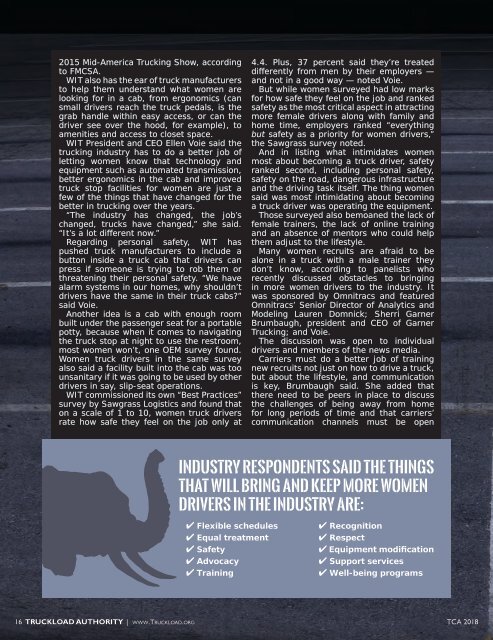TLA30_AllPages_RED
You also want an ePaper? Increase the reach of your titles
YUMPU automatically turns print PDFs into web optimized ePapers that Google loves.
2015 Mid-America Trucking Show, according<br />
to FMCSA.<br />
WIT also has the ear of truck manufacturers<br />
to help them understand what women are<br />
looking for in a cab, from ergonomics (can<br />
small drivers reach the truck pedals, is the<br />
grab handle within easy access, or can the<br />
driver see over the hood, for example), to<br />
amenities and access to closet space.<br />
WIT President and CEO Ellen Voie said the<br />
trucking industry has to do a better job of<br />
letting women know that technology and<br />
equipment such as automated transmission,<br />
better ergonomics in the cab and improved<br />
truck stop facilities for women are just a<br />
few of the things that have changed for the<br />
better in trucking over the years.<br />
“The industry has changed, the job’s<br />
changed, trucks have changed,” she said.<br />
“It’s a lot different now.”<br />
Regarding personal safety, WIT has<br />
pushed truck manufacturers to include a<br />
button inside a truck cab that drivers can<br />
press if someone is trying to rob them or<br />
threatening their personal safety. “We have<br />
alarm systems in our homes, why shouldn’t<br />
drivers have the same in their truck cabs?”<br />
said Voie.<br />
Another idea is a cab with enough room<br />
built under the passenger seat for a portable<br />
potty, because when it comes to navigating<br />
the truck stop at night to use the restroom,<br />
most women won’t, one OEM survey found.<br />
Women truck drivers in the same survey<br />
also said a facility built into the cab was too<br />
unsanitary if it was going to be used by other<br />
drivers in say, slip-seat operations.<br />
WIT commissioned its own “Best Practices”<br />
survey by Sawgrass Logistics and found that<br />
on a scale of 1 to 10, women truck drivers<br />
rate how safe they feel on the job only at<br />
4.4. Plus, 37 percent said they’re treated<br />
differently from men by their employers —<br />
and not in a good way — noted Voie.<br />
But while women surveyed had low marks<br />
for how safe they feel on the job and ranked<br />
safety as the most critical aspect in attracting<br />
more female drivers along with family and<br />
home time, employers ranked “everything<br />
but safety as a priority for women drivers,”<br />
the Sawgrass survey noted.<br />
And in listing what intimidates women<br />
most about becoming a truck driver, safety<br />
ranked second, including personal safety,<br />
safety on the road, dangerous infrastructure<br />
and the driving task itself. The thing women<br />
said was most intimidating about becoming<br />
a truck driver was operating the equipment.<br />
Those surveyed also bemoaned the lack of<br />
female trainers, the lack of online training<br />
and an absence of mentors who could help<br />
them adjust to the lifestyle.<br />
Many women recruits are afraid to be<br />
alone in a truck with a male trainer they<br />
don’t know, according to panelists who<br />
recently discussed obstacles to bringing<br />
in more women drivers to the industry. It<br />
was sponsored by Omnitracs and featured<br />
Omnitracs’ Senior Director of Analytics and<br />
Modeling Lauren Domnick; Sherri Garner<br />
Brumbaugh, president and CEO of Garner<br />
Trucking; and Voie.<br />
The discussion was open to individual<br />
drivers and members of the news media.<br />
Carriers must do a better job of training<br />
new recruits not just on how to drive a truck,<br />
but about the lifestyle, and communication<br />
is key, Brumbaugh said. She added that<br />
there need to be peers in place to discuss<br />
the challenges of being away from home<br />
for long periods of time and that carriers’<br />
communication channels must be open<br />
Industry respondents said the things<br />
that will bring and keep more women<br />
drivers in the industry are:<br />
4 Flexible schedules<br />
4 Equal treatment<br />
4 Safety<br />
4 Advocacy<br />
4 Training<br />
4 Recognition<br />
4 Respect<br />
4 Equipment modification<br />
4 Support services<br />
4 Well-being programs<br />
16 TRUCKLOAD AUTHORITY | www.Truckload.org TCA 2018

















